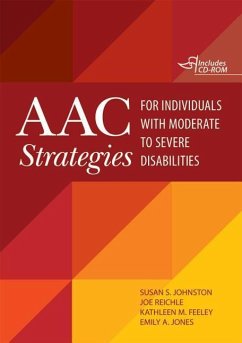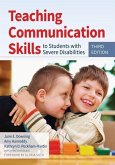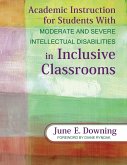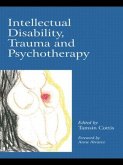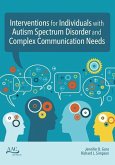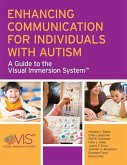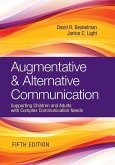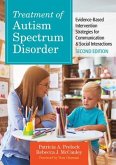Susan S. Johnston, Joe Reichle, Kathleen M. Feeley
Aac Strategies for Individuals with Moderate to Severe Disabilities
Susan S. Johnston, Joe Reichle, Kathleen M. Feeley
Aac Strategies for Individuals with Moderate to Severe Disabilities
- Broschiertes Buch
- Merkliste
- Auf die Merkliste
- Bewerten Bewerten
- Teilen
- Produkt teilen
- Produkterinnerung
- Produkterinnerung
Essential for SLPs, OTs, PTs, educators, and other professionals in school settings, this book helps readers establish a beginning functional communicative repertoire for learners with severe disabilities. Professionals will start with an in-depth intervention framework, including a guide to AAC modes and technologies, variables to consider when selecting AAC, and how AAC research can be used to support practice. Then they'll get explicit, evidence-based instructional strategies they'll use to help children and young adults.
Andere Kunden interessierten sich auch für
![Teaching Communication Skills to Students with Severe Disabilities Teaching Communication Skills to Students with Severe Disabilities]() June E DowningTeaching Communication Skills to Students with Severe Disabilities55,99 €
June E DowningTeaching Communication Skills to Students with Severe Disabilities55,99 €![Academic Instruction for Students with Moderate and Severe Intellectual Disabilities in Inclusive Classrooms Academic Instruction for Students with Moderate and Severe Intellectual Disabilities in Inclusive Classrooms]() June E. DowningAcademic Instruction for Students with Moderate and Severe Intellectual Disabilities in Inclusive Classrooms44,99 €
June E. DowningAcademic Instruction for Students with Moderate and Severe Intellectual Disabilities in Inclusive Classrooms44,99 €![Intellectual Disability, Trauma and Psychotherapy Intellectual Disability, Trauma and Psychotherapy]() Tamsin Cottis (ed.)Intellectual Disability, Trauma and Psychotherapy73,99 €
Tamsin Cottis (ed.)Intellectual Disability, Trauma and Psychotherapy73,99 €![Interventions for Individuals with Autism Spectrum Disorder and Complex Communication Needs Interventions for Individuals with Autism Spectrum Disorder and Complex Communication Needs]() Interventions for Individuals with Autism Spectrum Disorder and Complex Communication Needs55,99 €
Interventions for Individuals with Autism Spectrum Disorder and Complex Communication Needs55,99 €![Enhancing Communication for Individuals with Autism Enhancing Communication for Individuals with Autism]() Howard C. ShaneEnhancing Communication for Individuals with Autism54,99 €
Howard C. ShaneEnhancing Communication for Individuals with Autism54,99 €![Augmentative & Alternative Communication Augmentative & Alternative Communication]() Augmentative & Alternative Communication97,99 €
Augmentative & Alternative Communication97,99 €![Treatment of Autism Spectrum Disorder Treatment of Autism Spectrum Disorder]() Treatment of Autism Spectrum Disorder87,99 €
Treatment of Autism Spectrum Disorder87,99 €-
-
-
Essential for SLPs, OTs, PTs, educators, and other professionals in school settings, this book helps readers establish a beginning functional communicative repertoire for learners with severe disabilities. Professionals will start with an in-depth intervention framework, including a guide to AAC modes and technologies, variables to consider when selecting AAC, and how AAC research can be used to support practice. Then they'll get explicit, evidence-based instructional strategies they'll use to help children and young adults.
Hinweis: Dieser Artikel kann nur an eine deutsche Lieferadresse ausgeliefert werden.
Hinweis: Dieser Artikel kann nur an eine deutsche Lieferadresse ausgeliefert werden.
Produktdetails
- Produktdetails
- Verlag: Brookes Publishing Co
- Seitenzahl: 384
- Erscheinungstermin: 3. November 2011
- Englisch
- Abmessung: 265mm x 174mm x 22mm
- Gewicht: 738g
- ISBN-13: 9781598572063
- ISBN-10: 1598572067
- Artikelnr.: 33822534
- Herstellerkennzeichnung
- Libri GmbH
- Europaallee 1
- 36244 Bad Hersfeld
- 06621 890
- Verlag: Brookes Publishing Co
- Seitenzahl: 384
- Erscheinungstermin: 3. November 2011
- Englisch
- Abmessung: 265mm x 174mm x 22mm
- Gewicht: 738g
- ISBN-13: 9781598572063
- ISBN-10: 1598572067
- Artikelnr.: 33822534
- Herstellerkennzeichnung
- Libri GmbH
- Europaallee 1
- 36244 Bad Hersfeld
- 06621 890
Susan S. Johnston, Ph.D., Professor, Department of Special Education, University of Utah, 1705 East Campus Center Drive, Room 221, Salt Lake City, Utah 84112 Dr. Johnston conducts research, teaches, and provides technical assistance in the areas of augmentative and alternative communication, early language and literacy intervention, and early childhood special education. During her tenure at the University of Utah, Dr. Johnston served as Associate Dean for Academic Affairs for the College of Education and currently serves as Director of International Initiatives for the College of Education. She received her Master of Arts degree and doctorate in speech-language pathology from the University of Minnesota in Minneapolis. Joe Reichle, Ph.D., Professor, Speech-Language-Hearing Sciences, 115 Shevlin Hall, 164 Pillsbury Drive Southeast, University of Minnesota, Minneapolis, Minnesota 55455 Dr. Joe Reichle holds appointments in the Departments of Speech-Language-Hearing Sciences and Educational Psychology at the University of Minnesota. He is an internationally recognized expert in the areas of augmentative communication and communication intervention for persons with significant developmental disabilities and has written over 100 articles and chapters. Dr. Reichle has co-edited 10 books focused on his areas of expertise. He has served as a co-editor of the flagship journal (Journal of Speech-Language-Hearing Research) of the American Speech-Language and Hearing Association. Dr. Reichle was a former Associate Chair of the Department of Speech-Language-Hearing Sciences. During his 33-year career he has served as a PI, co-PI, and investigator on numerous federally funded projects. Currently, he is the Director of the University of Minnesota's Leadership Training Program in Neurodevelopmental Disabilities. Kathleen M. Feeley, Ph.D., Associate Professor, Department of Special Education and Literacy, C.W. Post Campus, Long Island University, Brookville, New York 11367 Dr. Feeley is the clinical coordinator for the Certifi cate in Autism and Special Education Program at C.W. Post Campus, Long Island University. As the founder and director of the Center for Community Inclusion at C.W. Post Campus, Dr. Feeley provides training and technical assistance to families, school districts, and adult service agencies as they include individuals with developmental disabilities within their communities. She is also Senior Editor for the journal Down Syndrome Research and Practice and is a member of the international research group Research Action for People with Down Syndrome (RAPID), sponsored by Down Syndrome International. Emily A. Jones, Ph.D., Assistant Professor, Department of Psychology, Queens College, City University of New York, Flushing, New York 11367 Dr. Jones received her doctorate in clinical psychology from the State University of New York Stony Brook. She was Associate Professor in the Department of Psychology at C.W. Post Campus, Long Island University. Dr. Jones teaches courses in applied behavior analysis and developmental disabilities. She also provides training and technical assistance to families, school districts, and other service providers to support children with developmental disabilities in inclusive settings. Dr. Jones's research involves the development and demonstration of interventions to address early emerging core deficits in young children with developmental disabilities such as autism and Down syndrome. Her current interests are in the area of social and communication skills, including joint attention in children with autism and early requesting skills in children with Down syndrome. Nancy C. Brady, Ph.D., Associate Professor, Department of Speech Language Hearing Sciences and Disorders, University of Kansas, 1000 Sunnyside Avenue, Lawrence, Kansas 66045 Dr. Nancy Brady conducts research on early language and communication development in children and adults with severe disabilities, including individuals with autism, fragile x syndrome and deaf-blindness. Her research focuses on stages of prelinguistic development, assessing communication, teaching beginning AAC, and pragmatic aspects of early communication. Dr. Smith is a New York State Licensed Psychologist. He has worked with children and adults with a variety of disabilities for over 20 years. His clinical and research interests include assessing and treating challenging behavior and functional communication training, Krista M. Wilkinson, Ph.D., Professor, Department of Communication Sciences and Disorders, The Pennsylvania State University, 308 Ford Building, University Park, Pennsylvania, 16802 Dr. Krista Wilkinson is Professor at the Pennsylvania State University and Editor of the American Journal of Speech-Language Pathology (2014-2016). Dr. Wilkinson's research applies the tools of neuroscience to understand visual and cognitive processing of individuals with severe disabilities, in order to optimize visual augmentative and alternative communication interventions used to support their communication functioning.

